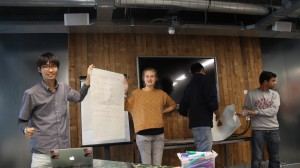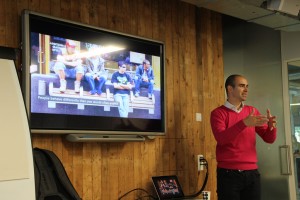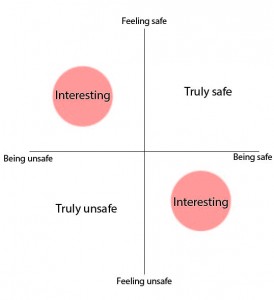Workshop on Design Research by Marco van Hout (September 18)
Conflicting concerns
This morning there was a workshop on Design Research. We started talking about conflicting concerns and how this appears almost in every design. So for example if you have a smartphone, it is great that you can contact a lot of people, but the problem is that you don’t look around you anymore. This comes with a lot of products. With our problem, the most difficult thing is that objective safety and subjective safety are sometimes conflicting. We should try to make people be safe and feel safe.
Research questions
After this, each group showed their research questions to each other. Our research questions were fine (Maybe because we already discussed it with Marco, hehe), but there was one thing that had to be changed. This used to be our main research question: What are the determinants that influence women’s feelings of unsafety in Amsterdam and what are factors that should be taken into account when designing interventions that can have a real impact? The problem with this question was, that we used the word determinants and factors, which makes it kind of weird. The factors are actually some of the determinants, so we should put it like this:
What are the determinants that influence women’s feelings of unsafety in Amsterdam and which of those should be taken into account when designing interventions to positively influence the unsafe feeling of women in Amsterdam?
Maybe this question will need some changes, but we will see that later.
Methods to use
The methods which Marco told us about were : 1. Design etnography (interview/observation) 2. Experience design (touch points) 3. Empathy (experience the same as the user) 4. Primary research (field research) 5. Secondary research (books)
Break up letters
This is all great, but Marco told us we should also do stuff like writing break up letters and bodystorming. Yes, that sounds weird, but those are innovative methods to get more creativity going on. We all wrote a break up letter for a product which we don’t like anymore. This way, you can easily find out what people think is wrong with the product and what used to be interesting. Here is one letter to my toilet that is flushed electronically:
Dear ‘maal’ toilet,
You have been making too much noise. I don’t understand you anymore, cause I can’t make something out of the noise you make. Also, sometimes you smell really bad. The other problem is that I often have to explain people how to treat you constantly, cause you are such a complex person. You make my life so difficult, when actually it should be easy. I will get someone new: someone who is easier to handle.
Goodbye, Laura
Bodystorming
This was fun. There was something more fun yet to come. We did a bodystorming session is which we showed a solution to the audience by demonstrating it. Shin was a superhero, Adwait was a dangerous person, Akarsh was the panic button and I was the user. You can fill in the rest for yourself..








 The other important thing was the fear of crime paradox which Van ‘t Hof talks about in his research on the railway stations. Where people feel safe, they are mostly unsafe. He gave the example of the center of Amsterdam where people feel safe, but actually they are the least safe. He also mentioned the bystander effect which entails that when there are more people around, people tend to offer less help to victims. This is interesting, since in busy places, people actually feel more safe, but when something happens, they will not get a lot of help.
The other important thing was the fear of crime paradox which Van ‘t Hof talks about in his research on the railway stations. Where people feel safe, they are mostly unsafe. He gave the example of the center of Amsterdam where people feel safe, but actually they are the least safe. He also mentioned the bystander effect which entails that when there are more people around, people tend to offer less help to victims. This is interesting, since in busy places, people actually feel more safe, but when something happens, they will not get a lot of help.